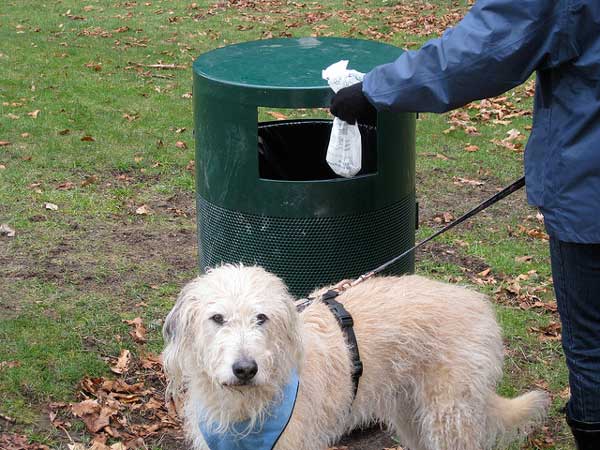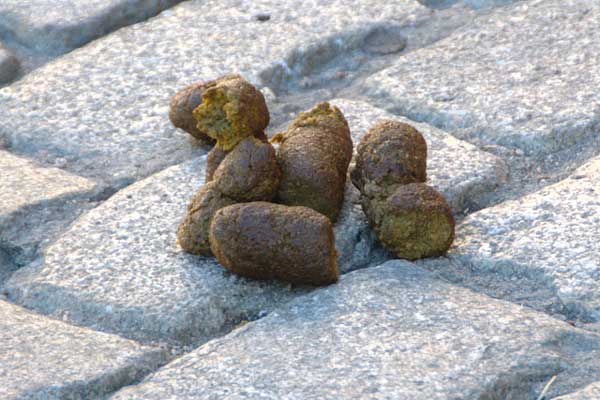Citizen Science Tuesday connects you with opportunities to be a part of conservation science with outdoor projects around the world and online projects to try from the comfort of your own home.
By Lisa Feldkamp, senior coordinator, new science audiences, The Nature Conservancy
What is PooPower!?
Remember the last time you stepped into a pile of dog excrement? Chances are, it’s not a pleasant memory.
Now think about that stinky, smelly mess – in your drinking water.
It’s a BIG problem. In America, pet dogs produce about 10 million tons of poo each year.
If that poo doesn’t get properly scooped and disposed of, it ends up going untreated into our stormwater and from there it can end up in drinking water.
That’s not just a big mess; the bacteria in dog waste could have serious implications for the environment and human health.
“The problem is universal and the simple act of cleaning up after your dog has environmental benefits as well as personal health benefits. Yes, the environmental benefits of reduced pollution in our parks, streets and waterways are apparent, but many people are unaware that the bacteria in dog waste are potentially a hazard to us as well,” says Duncan Chew, Project & Community Engagement Manager of PooPower.
PooPower! is a project that started in Australia using citizen science to map dog poo ‘hotspots’ and encourage people to come up with solutions.
They are working to transform the poo problem into an energy solution with biogas made from doggy doo.
Why is PooPower! Important?
Dog feces has a lot of bacteria, more even than human feces. The EPA has many resources on best practices for disposing of waste and reasons to do so. One fact sheet notes “a day’s waste from one large dog can contain 7.8 billion fecal coliform bacteria, enough to close 15 acres of shellfish beds.”
Excess nutrients in the water from dog waste could also contribute to algal blooms that are bad for fish, other aquatic life, and our drinking water.
“In extreme cases eutrophication [excess nutrients] will deplete the waterway of its oxygen and impact the health of plants and animals,” Chew explains.
Picking up after your dog is more than a courtesy; it’s conservation.

Recommended disposal options for dog poo (flushing, trashing, and burial) are often imperfect. Flushed dog stool can overwhelm the sewage system and with both trash and burial there is still a chance that the feces will wash out into the water system.
That is why projects like PooPower! are working on using dog poo for biogas. This solution keeps the poop out of the water system and provides an alternate, renewable energy source.
PooPower! also taps the potential of dog feces to get kids excited about science.
Dog poop is part of our every day lives, easy to find, and it ties in to many science and social science topics.
Starting from dog poo, teachers can lead into discussions of watersheds, bacteria, social systems and much more.
How Do You Get Involved in PooPower!?
Get started finding dog poo hotspots in your area with the iPhone app.
“People have the best sense of humour when it comes to dog poo and the Poo Power! iPhone app is the best example of that. Citizen scientists around the world are quite happy to take photos of dog poo to be publicly published and GPS-tagged on our map,” says Chew.
Then learn more about the options for disposing of dog waste in your area. If you’re not satisfied with currently available options, go to your city government with ideas for improvement.
Don’t be afraid to educate your neighbors (politely).
“What people can do is support each other in improving the cleanliness of our parks and streets. If you’re out walking the dog and see someone who doesn’t clean up after them, offer them one of your dog poo bags as a gentle reminder to do the right thing,” Chew advises.
You might get some strange looks when you’re taking pics of dog poo, but give it a try. It may lead to some very productive conversations.
More recent research on how our canine companions impact local ecology.
Is there a citizen science project that you think deserves more attention? Contact Lisa Feldkamp, lfeldkamp[at]tnc.org or leave a comment below with a link to make a recommendation for Citizen Science Tuesday.
Opinions expressed on Cool Green Science and in any corresponding comments are the personal opinions of the original authors and do not necessarily reflect the views of the Nature Conservancy.




In the past few months I have gotten an earthworm farm. Earthworms like the poop…. I don’t know if you can work that into your green scheme or not…. Underground bin to drop into instead of plastic bags in landfills getting rained on and ending up…. In the water… That seems like it would end the pretend solutions… I don’t own dogs so definitely a look from the outsider…. Love to ya from Texas! Good luck with that!
Thanks Shaun! I don’t know whether this could work along with the bioenergy plan, but I could see earthworm farms as another potential solution as long as they’re contained in such a way that rain can’t make them overflow before the earthworms have done their work.
Hi Saunie
Unfortunately there are no plans to develop an Android version of the app at this stage, however if you like to participate you can email your photo directly to me with the location and I can manually upload it for you. There have been some US “sightings”(lol) but like you I’d love to see more!
Lisa has also asked me to contribute to the article about the efficiency of biogas generation from dog waste. From a comparative study in 2010 (Okoroigwe, et al.; ISSN 189-3579) and from other research, we know that dog waste doesn’t quite have the energy factor as some other organic wastes but it does have a sustained gas production once those bacteria get going. It was never the intent of Poo Power! to use dog waste alone (although it was successfully done in a proof of concept trial) however a combination with other wastes such as grass to give the anaerobic digester a higher, faster and longer efficiency in gas production.
Happy to answer more questions 🙂
Duncan & Diesel
I would really like to be a part, I walk dogs for a living and have good data. But I am an Android user. Any chance it’s being developed for Android?
Thanks Saunie! Good question- I will check with Duncan. I was looking at the map earlier and it definitely needs some US sightings!